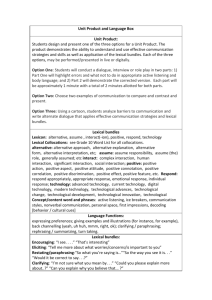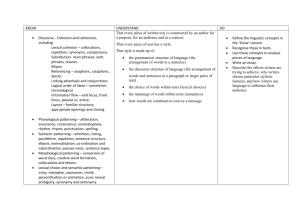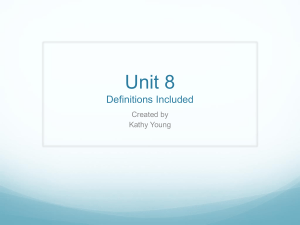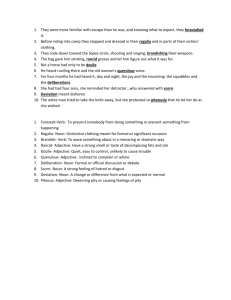Discourse Community Analysis 2 REV EW
advertisement
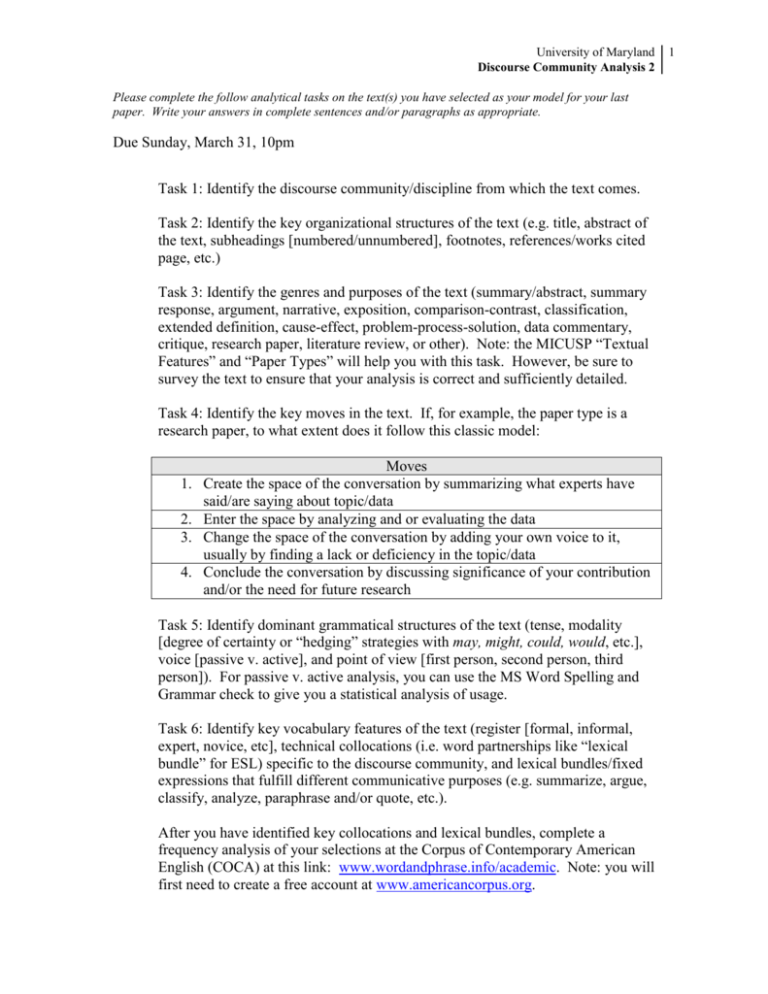
University of Maryland Discourse Community Analysis 2 Please complete the follow analytical tasks on the text(s) you have selected as your model for your last paper. Write your answers in complete sentences and/or paragraphs as appropriate. Due Sunday, March 31, 10pm Task 1: Identify the discourse community/discipline from which the text comes. Task 2: Identify the key organizational structures of the text (e.g. title, abstract of the text, subheadings [numbered/unnumbered], footnotes, references/works cited page, etc.) Task 3: Identify the genres and purposes of the text (summary/abstract, summary response, argument, narrative, exposition, comparison-contrast, classification, extended definition, cause-effect, problem-process-solution, data commentary, critique, research paper, literature review, or other). Note: the MICUSP “Textual Features” and “Paper Types” will help you with this task. However, be sure to survey the text to ensure that your analysis is correct and sufficiently detailed. Task 4: Identify the key moves in the text. If, for example, the paper type is a research paper, to what extent does it follow this classic model: 1. 2. 3. 4. Moves Create the space of the conversation by summarizing what experts have said/are saying about topic/data Enter the space by analyzing and or evaluating the data Change the space of the conversation by adding your own voice to it, usually by finding a lack or deficiency in the topic/data Conclude the conversation by discussing significance of your contribution and/or the need for future research Task 5: Identify dominant grammatical structures of the text (tense, modality [degree of certainty or “hedging” strategies with may, might, could, would, etc.], voice [passive v. active], and point of view [first person, second person, third person]). For passive v. active analysis, you can use the MS Word Spelling and Grammar check to give you a statistical analysis of usage. Task 6: Identify key vocabulary features of the text (register [formal, informal, expert, novice, etc], technical collocations (i.e. word partnerships like “lexical bundle” for ESL) specific to the discourse community, and lexical bundles/fixed expressions that fulfill different communicative purposes (e.g. summarize, argue, classify, analyze, paraphrase and/or quote, etc.). After you have identified key collocations and lexical bundles, complete a frequency analysis of your selections at the Corpus of Contemporary American English (COCA) at this link: www.wordandphrase.info/academic. Note: you will first need to create a free account at www.americancorpus.org. 1 Create a chart with 2 columns—key collocations and purpose/key lexical bundles—and record the most frequent examples in each column and the percentage they were used in the text. Key collocations & % of usage in the text according to www.wordandphrase.info/academic (article) + adjective + noun (e.g. (a) lexical bundle 17% frequency 1. 2. 3. 4. 5. 6. Purpose/key lexical bundles in the text www.wordandphrase.info/academic To summarize/key lexical bundles (article) + noun + noun (e.g. (a) noun phrase 47% frequency 1. 2. 3. 4. 5. 6. To report/key lexical bundles (article) + noun + preposition + (adjective/article) + noun (e.g. (a) choice of (the right) register 23% frequency 1. 2. 3. 4. 5. 6. Etc. verb) + noun + preposition (e.g. conduct + research + on 5% frequency 1. 2. 3. 4. 5. 6. 1. As we have seen (5%) 2. So, (12%) 3. In the above (.5%) 4. etc. 5. 6. 1. Studies show (1%) 2. etc. 3. 4. 5. 6. University of Maryland Discourse Community Analysis 2 Task 7: Identify types of evidence in the text (e.g. charts, graphs, quotations/paraphrases of experts, facts, statistics, formulae, examples, anecdotes, etc.) and citation convention (e.g. American Psychological Association (APA), Modern Language Association (MLA), Chicago, other) Task 8 (Due Monday, April 1, 10pm): write a 7 paragraph (1 paragraph per task) analysis of your results. Post your analysis with your name at the Research Project page of the wiki. 3
